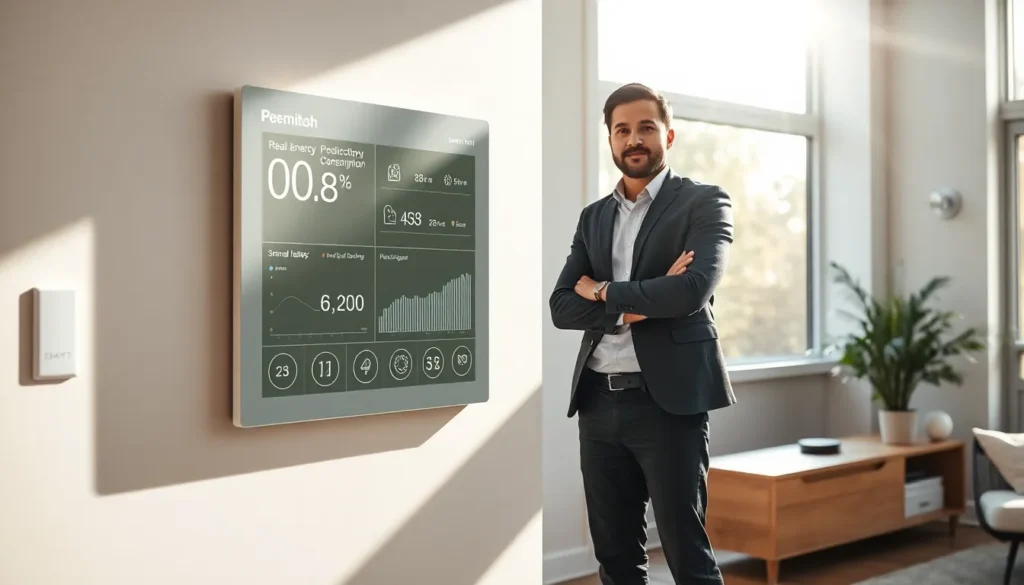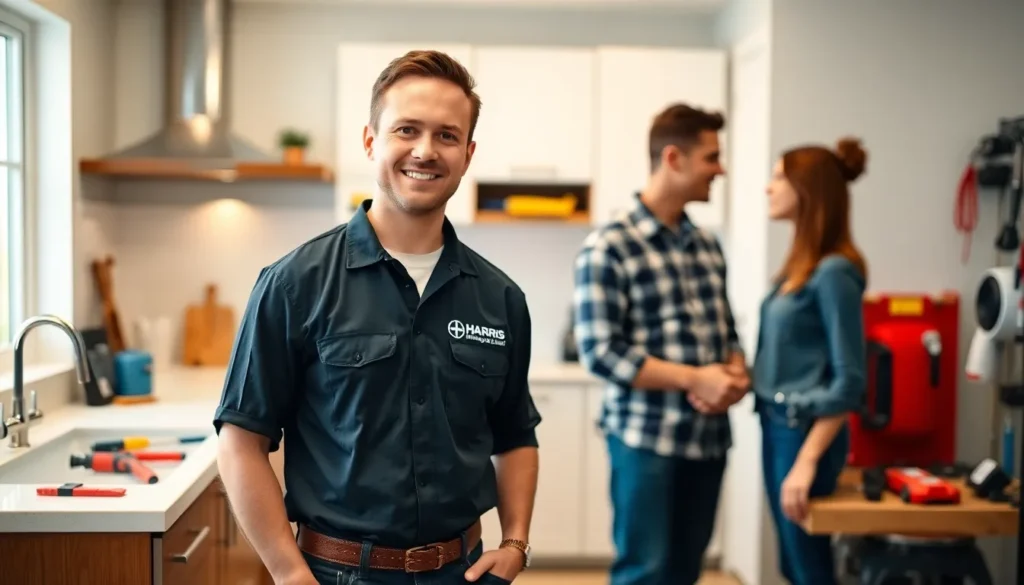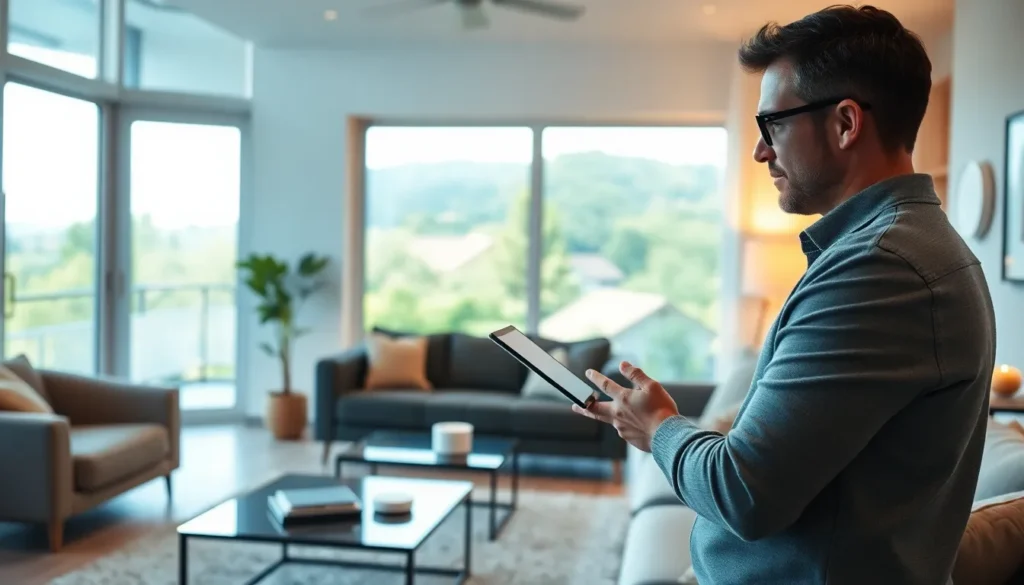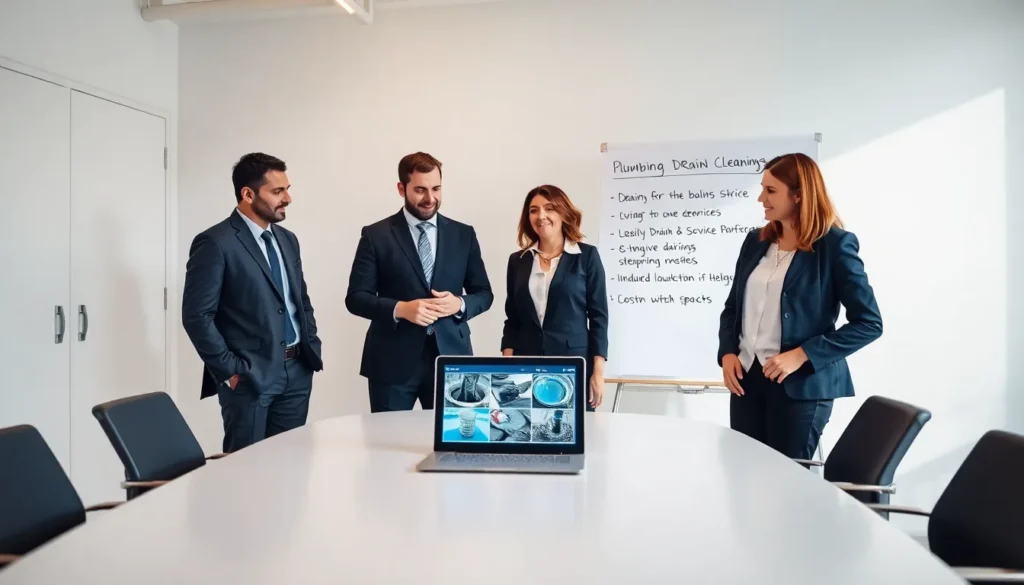In today’s fast-paced world, the concept of a technology-driven home is transforming how people live. Smart devices and innovative solutions are no longer just luxuries; they’re essential components of modern living. From voice-activated assistants to automated lighting systems, technology is streamlining daily tasks and enhancing comfort.
As homeowners embrace these advancements, they’re discovering the myriad benefits of a connected lifestyle. Energy efficiency, security, and convenience are just a few perks that come with integrating smart technology into the home. This article explores the latest trends and essential tools that make a technology-driven home not just a dream but a reality for many.
Table of Contents
ToggleOverview of Technology-Driven Homes
Technology-driven homes represent a significant shift in modern living. These residences utilize smart devices and systems to enhance functionality and improve quality of life. From integrated security systems to automated lighting and smart thermostats, these technologies offer numerous benefits.
Key Features
- Connectivity: Devices connect through a central hub, allowing seamless communication and control. This connectivity ensures homeowners can manage multiple systems from one interface.
- Energy Efficiency: Smart technology optimizes energy use, reducing costs. For example, programmable thermostats can adjust heating and cooling based on occupancy patterns, leading to savings of up to 30% on energy bills.
- Enhanced Security: Smart security systems provide real-time monitoring and alerts. Surveillance cameras, smart locks, and motion sensors allow homeowners to monitor their properties remotely.
- Convenience: Automated systems simplify daily tasks. Voice assistants control lights, appliances, and entertainment systems, providing immediate access to desired functions.
- Comfort: Smart climate control devices create personalized environments. Homeowners can adjust settings remotely or set routines for optimal comfort levels throughout the day.
Recent Trends
- Interoperability: Increased focus on devices that work together across different brands, enhancing the user experience.
- Health Monitoring: Integration of health technologies to track indoor air quality and promote wellness.
- Sustainability: Adoption of eco-friendly devices, such as solar-powered smart gadgets and energy-efficient appliances.
Technology-driven homes continue to evolve, making innovative solutions accessible and essential for homeowners aiming for a connected and efficient lifestyle.
Key Components of a Technology-Driven Home

Technology-driven homes feature essential components that enhance living standards. Key elements include smart devices and home automation systems, which collectively improve accessibility, comfort, and efficiency.
Smart Devices
Smart devices play a vital role in the functionality of a technology-driven home. Examples include:
- Smart Speakers: Enable voice control for various tasks like music playback and information retrieval.
- Smart Thermostats: Optimize energy use by adjusting temperature settings based on occupancy and preferences.
- Smart Lighting: Allows users to control lighting remotely or set schedules for energy savings.
- Smart Security Cameras: Provide real-time surveillance and notification of unauthorized access.
These devices integrate seamlessly, creating a cohesive user experience that enhances convenience and security.
Home Automation Systems
Home automation systems centralize control over various smart devices, streamlining daily operations. Key features include:
- Central Hubs: Facilitate connectivity among devices, allowing users to manage them through a single interface.
- Automated Scheduling: Enables users to set routines for lights, heating, and security systems, enhancing energy efficiency.
- Remote Access: Allows users to monitor and control home features via smartphones or tablets, regardless of location.
- Interoperability: Ensures compatibility between different manufacturers’ products, enhancing flexibility in choice.
Home automation systems simplify the interaction with smart devices, contributing to an improved quality of life while supporting energy-efficient practices.
Benefits of Living in a Technology-Driven Home
Living in a technology-driven home offers numerous advantages that significantly enhance daily life. These benefits include enhanced comfort, convenience, energy efficiency, and cost savings.
Enhanced Comfort and Convenience
Enhanced comfort and convenience become a reality with technology-driven homes. Smart thermostats automatically adjust temperatures based on preferences, ensuring optimal comfort. Smart lighting systems allow users to control brightness and color through apps or voice commands, creating tailored atmospheres for different activities. Home automation systems streamline daily routines by scheduling tasks like turning on appliances or adjusting window coverings. Automated shades respond to external lighting conditions, improving privacy and comfort. Smart speakers integrated with home systems enable consumers to manage their environment using simple voice commands, significantly increasing overall ease of living.
Energy Efficiency and Cost Savings
Energy efficiency and cost savings significantly improve with technology-driven homes. Smart appliances optimize energy consumption by adapting usage patterns to peak and off-peak hours. Smart thermostats use algorithms to maximize heating and cooling efficiency, reducing energy waste and leading to lower utility bills. Homeowners can monitor energy usage in real-time through apps, identifying patterns and making informed decisions to enhance conservation. According to the U.S. Department of Energy, smart homes can save up to 30% on energy costs annually. Automated lighting systems turn off lights in unoccupied rooms, contributing to further savings. Adopting these technologies can result in reduced environmental footprints and tangible financial benefits.
Challenges and Considerations
Homeowners must navigate certain challenges with technology-driven homes. Key considerations include security concerns and dependency on technology.
Security Concerns
Smart devices enhance a home’s security but introduce vulnerabilities. Cybersecurity threats, such as hacking and data breaches, pose risks to personal information. Manufacturers often update devices with patches, yet users must remain vigilant about keeping software current. Strong, unique passwords and two-factor authentication help mitigate risks. Homeowners should also assess the security features of devices before purchase, ensuring they provide robust protection.
Dependency on Technology
Reliance on technology can create challenges in technology-driven homes. System failures, software glitches, or power outages may disrupt daily activities and leave homeowners temporarily without control of their environments. To address this dependency, individuals should consider backup options, such as manual overrides for key systems. Awareness of how these technologies work is crucial, empowering homeowners to manage potential issues effectively. Maintaining a balance between convenience and independence remains essential for sustainable living in a technology-driven environment.
Future Trends in Technology-Driven Homes
Technology-driven homes face rapid evolution, with emerging trends shaping the future of smart living. Key developments include:
- Voice-Controlled Systems
Voice-controlled systems become increasingly prevalent. Virtual assistants, like Amazon Alexa and Google Assistant, facilitate seamless interaction with smart devices. These systems optimize convenience and streamline daily operations.
- Advanced Home Security
Advanced home security features enhance safety measures. Facial recognition technology and AI-powered cameras improve real-time monitoring. Increased integration with emergency services offers immediate responses during security breaches.
- Energy Management Solutions
Energy management solutions gain significance in maintaining efficiency. Smart energy meters track consumption patterns and adjust energy use accordingly. Integration with renewable energy sources, like solar panels, becomes standard practice.
- Interconnectivity of Devices
Interconnectivity among various smart devices continues to rise. Standards like Matter promote compatibility across brands, ensuring harmonious operation. Users experience greater flexibility in choosing products without manufacturer restrictions.
- Health and Wellness Integration
Health and wellness technology adopts a central role. Smart home devices monitor air quality and humidity levels, promoting optimal living conditions. Automated alerts notify homeowners of potential health risks, enhancing overall well-being.
- Augmented Reality and Virtual Reality
Augmented reality (AR) and virtual reality (VR) applications emerge in home design and maintenance. Homeowners can visualize changes before committing to renovations, simplifying decision-making. Maintenance tasks can also be guided through immersive experiences.
- Sustainability Features
Sustainability features become a priority for homeowners. Eco-friendly smart appliances and water-saving devices reduce environmental impact. Technology-driven homes increasingly showcase sustainable practices in energy and resource management.
- Smart Appliances Evolution
Smart appliances evolve beyond basic functions. Refrigerators can create inventories and suggest recipes based on available ingredients. Washers and dryers schedule operations based on energy tariffs, optimizing cost efficiency.
- Centralized Control Systems
Centralized control systems become essential for managing interconnected devices. Homeowners benefit from unified platforms that offer a single interface for diverse functionalities. Enhanced user experiences foster engagement with smart home technology.
- Remote Health Monitoring
Remote health monitoring grows in popularity, especially among senior citizens. Smart home technology supports telehealth services and remote monitoring, allowing caregivers to track health metrics. This trend promotes independent living while ensuring safety.
These trends reflect the ongoing advancements in technology-driven homes, making them increasingly dynamic and integral to modern lifestyles.
The evolution of technology-driven homes marks a significant shift in how people live and interact with their environments. Embracing smart devices and home automation systems enhances daily life through improved comfort and efficiency. As homeowners navigate the challenges of security and dependency on technology, staying informed and proactive is key to maximizing the benefits of these advancements.
Future trends indicate a growing integration of health and wellness technology alongside sustainable solutions. This dynamic landscape promises to redefine modern living, making technology-driven homes not just a trend but a vital aspect of everyday life. As innovation continues to unfold, the potential for smarter, more connected living spaces remains limitless.









